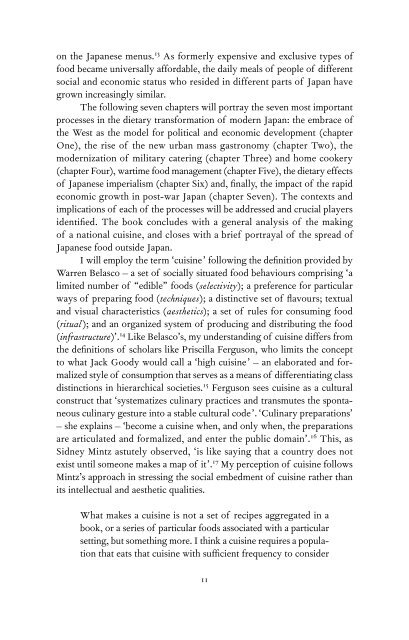Download - Brainshare Public Online Library
Download - Brainshare Public Online Library
Download - Brainshare Public Online Library
You also want an ePaper? Increase the reach of your titles
YUMPU automatically turns print PDFs into web optimized ePapers that Google loves.
on the Japanese menus. 13 As formerly expensive and exclusive types of<br />
food became universally affordable, the daily meals of people of different<br />
social and economic status who resided in different parts of Japan have<br />
grown increasingly similar.<br />
The following seven chapters will portray the seven most important<br />
processes in the dietary transformation of modern Japan: the embrace of<br />
the West as the model for political and economic development (chapter<br />
One), the rise of the new urban mass gastronomy (chapter Two), the<br />
modernization of military catering (chapter Three) and home cookery<br />
(chapter Four), wartime food management (chapter Five), the dietary effects<br />
of Japanese imperialism (chapter Six) and, finally, the impact of the rapid<br />
economic growth in post-war Japan (chapter Seven). The contexts and<br />
implications of each of the processes will be addressed and crucial players<br />
identified. The book concludes with a general analysis of the making<br />
of a national cuisine, and closes with a brief portrayal of the spread of<br />
Japanese food outside Japan.<br />
I will employ the term ‘cuisine’ following the definition provided by<br />
Warren Belasco – a set of socially situated food behaviours comprising ‘a<br />
limited number of “edible” foods (selectivity); a preference for particular<br />
ways of preparing food (techniques); a distinctive set of flavours; textual<br />
and visual characteristics (aesthetics); a set of rules for consuming food<br />
(ritual); and an organized system of producing and distributing the food<br />
(infrastructure)’. 14 Like Belasco’s, my understanding of cuisine differs from<br />
the definitions of scholars like Priscilla Ferguson, who limits the concept<br />
to what Jack Goody would call a ‘high cuisine’ – an elaborated and formalized<br />
style of consumption that serves as a means of differentiating class<br />
distinctions in hierarchical societies. 15 Ferguson sees cuisine as a cultural<br />
construct that ‘systematizes culinary practices and transmutes the spontaneous<br />
culinary gesture into a stable cultural code’. ‘Culinary preparations’<br />
– she explains – ‘become a cuisine when, and only when, the preparations<br />
are articulated and formalized, and enter the public domain’. 16 This, as<br />
Sidney Mintz astutely observed, ‘is like saying that a country does not<br />
exist until someone makes a map of it’. 17 My perception of cuisine follows<br />
Mintz’s approach in stressing the social embedment of cuisine rather than<br />
its intellectual and aesthetic qualities.<br />
What makes a cuisine is not a set of recipes aggregated in a<br />
book, or a series of particular foods associated with a particular<br />
setting, but something more. I think a cuisine requires a population<br />
that eats that cuisine with sufficient frequency to consider<br />
11







